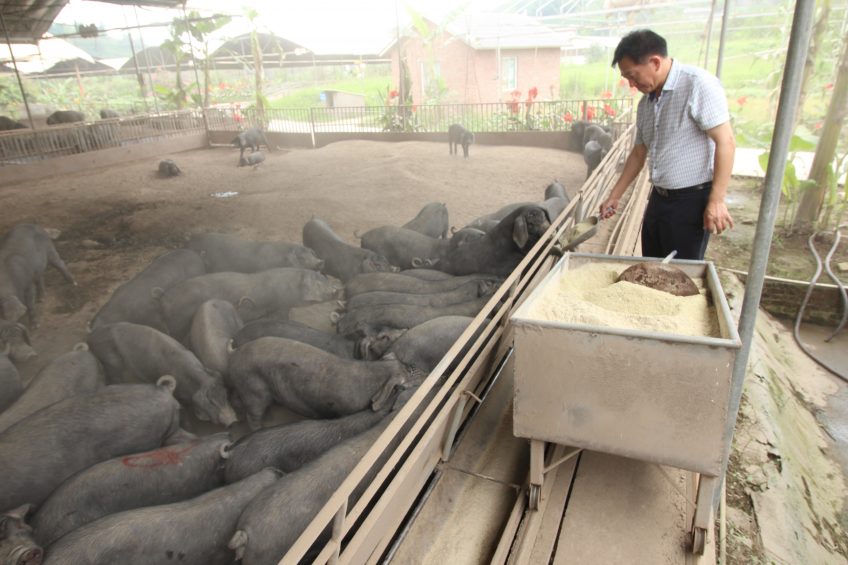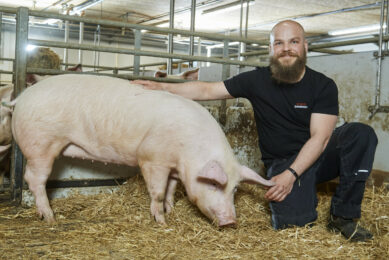A sandy pig farm at the shores of the Yangtze

China, with half of all the global pig population within its borders, has an abundance of different pig holding systems. One giant complex after another is being built following western examples – but that’s not the whole story. Fuling Black Pig Farm, near Chongqing, China, focuses on growing a local breed, and developed a unique production system.
Anybody visiting a swine herd knows it’s best to approach a herd quietly. After all it only takes one panicking pig that has been woken up by surprise – and the whole herd tramples its way to the back. At Fuling Black Pig Farm, exactly that phenomenon leads to a true Wild West effect as it sends thick sand and dust clouds flying around. It takes a while before the hiding herd can be observed again, the pigs then come closer and are keen to meet the visitors.
Sandy floors at Fuling
The sand is one of the key components of Fuling Black Pig farm, at about two hours’ drive west of the metropolis Chongqing, China, in the heart of China. Not only are the nursery pigs and the finishers kept on sand, so are the newborn piglets in the lactation area. Especially in the pig houses for grow-finishers, the areas look like dunes, with plenty of space to root, deep holes to lie in and hills to run over. Before the animals are sent in, the floor is even, assures owner and president Li Hailin. The eventual moon landscape is the pigs’ own doing.

Sand is plentiful at the farm, which is located in the village Nantuo. Literally around the corner from the village is the mighty Yangtze river, which provides daily new rations of sand, enough to allow the farm to keep a pile on-farm and to replenish the pig houses every time a batch has left the farm. The sand that is taken out contains manure and urine and will therefore make rich soil. As soon as a finisher pig house is ‘empty’, the linen roof can easily be taken off and the site underneath the pig house carcass will be temporarily used for crop growth. At the farm, therefore, for instance vegetable and banana plant cultivation can be noted for that reason as well. The type of crops differ; it depends on the season as well as on the price of the crops on the market.

The Black Pig story
But it’s not only the sand that tells the story of Fuling Black Pig Farm. The farm breeds Black Pigs (黑猪, pronounciation ‘hei zhu’). This is a breed that has been known for thousands of years in China for its rich meat flavour and thick fat layers. Typically, animals of this breed have a wrinkled snout, can have large litters, although not as large as the Meishan, and can deal perfectly with hot and humid conditions like during summer, Chongqing province can be sweltering hot.
The farm’s owner is Li Hailin, a rich local entrepreneur who owns about 400 mu (26.7 ha) of land. He started his pig farm in 2002, converted to black pig growing in 2008, introduced the sandy floors in 2015 and has kept on expanding and innovating his business ever since. For environmental reasons, the local government told him that only extensive production was allowed in this location, hence he chose black pigs on his farm. In lactation, the piglets are kept in wide pens of 2×2.5 m, after weaning at 30 days, the grow-finisher pigs are kept in one and the same sandy area. There are sandy finisher pig houses of different sizes, but key is that the animals have on average 4 m2 of sandy area per animal.
PROFILE

Name: Mr Li Hailin, age 55
Location: Nantuo, Chongqing municipality, China
Farm: Fuling Black Pig Farm in total has 1,200 sows and produces about 30,000 finisher pigs for the market in the Chongqing area. Black pigs are known to have large litters, which can be as high as 18 piglets per litter.
At Fuling farm, the average litter size is 16. The concept doesn’t use any antibiotics – but applies vaccination in combination with herbal medicines. All pigs are castrated, with the exception of those used for breeding.
Keeping black pigs is a lucrative business, Mr Li says, as he receives double the market price for the meat. At the time of the visit, 1 kg of pork was RMB 14.8 (€ 1.87); in that week, Mr Li would have sold the meat at RMB 29.6 (€ 3.73).

The Black Pig Integration
In fact, Fuling Black Pig Farm operates like a true integrated chain. The farm owns various sow locations. The main location in Nantuo has 800 sows and elsewhere another 400 can be found. The main location consists of a total of roughly 90 buildings equalling 40,000 m2 of pig farm space. All in all, Fuling Black Pig Farm produces about 30,000 finisher pigs per year.

The farm has a feed mill of its own, where it produces mash mixtures of corn, soybean, wheat bran, rice bran and leftover products. No artificial components are added to the feed. In addition, the farm has a slaughterhouse of its own, about 2-3 km away from the farm facilities. Once slaughtered, the meat gets a special Black Pig brand and is sold at 160 outlets throughout the Chongqing municipality (accommodating 32 million people). Half of these are own shops, the other half are supermarkets.

Interestingly, not all pigs are finished partly on-site. At 50 kg, a part of them is ‘lent out’ to local farmers in the area who can opt for the installation of a ‘pop-up’ finishing house for either 50 or 100 black finisher pigs, typically measuring about 60 to 120 m2. In five days, such a pop-up facility (an invention of Mr Li himself) can be created, after which the farmer can take care of the pigs himself until they reach slaughterweight, which is anywhere between 125 and 145 kg. Farmers receive a part of the profit of the farm, and on top, they can ‘catch’ the manure underneath the pop-up facility which is about 2.5 m above the floor and they can use it to fertilise their own land. These moveable units don’t come with a sandy floor, but are divided into a solid floor and a slatted floor for dunging purposes. In total, the company owns about 30 of these moveable pig locations.
| Help from an academy Fuling Black Pig Farm is supported technologically by the Chongqing Academy of Animal Sciences. This academy forms the selection programme, dispatches the technicians to participate in the tasks of replacement selection, performs finishing performance testing, mating ability testing and indexes selection, breeder selection and breeding plan. In addition, they conduct the research in e.g. hair colour molecular marking, the functionality of meat quality characteristics, intra-muscular fat prediction technology. Jointly with the farm, they have embarked on projects called ‘The selection and utilisation of the Fuling Black pig’, ‘Protection and selection of the Pengzhou Mountain pig and its demonstration’. Through conducting these projects, the breeding work is being promoted. |
Feed is provided by Mr Li’s company and delivered once every four days at the contract growers. Alfalfa powder is often mixed through the rations. The growers often also add local vegetables as well as byproducts to the black pigs’ diets.
Breeding programme
As Fuling Black Pig Farm is a closed herd, the farm breeds its own black pig sows, with several sows clearly identified with coloured ear tags to maintain the purebreds.
For the eventual slaughter pigs, parent stock are bred using artificial insemination, with semen from a crossbred Duroc/Berkshire boar. This gives litters with a mixture of colours. After weaning, all the animals are selected on colour and on typical black pig traits, as on the market what matters is the black pig appearance. Those matching the black pig criteria sufficiently, will form batches – and so will the coloured or off-black pigs. Most of the coloured animals will also be finished on-farm. The price for the pork of the coloured pigs will be identical on the market.

The programme has been very successful and usually makes good money. For the near future, the farm will therefore expand with another 20,000 m2 of sand pig pens. In addition, more contract farmers will be supplied with removable pig houses – another 100 will become available for households in the surrounding area.
This article was constructed with the kind help of Ms Zhu Dan and Ms Wen Liu.











